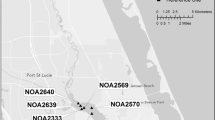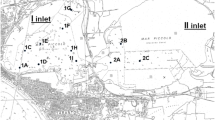Abstract
This study assesses the effect of salinity in bioavailability and toxicity of Zn by means of laboratory bioassays by observing contamination in both sediment and water, accumulation of Zn in biological tissues, and histopathological damage in the gills and guts tissues of Ruditapes philippinarum clams, which were exposed to different types of sediments from the Gulf of Cádiz (SW Spain) as well as two dilutions of toxic mud coming from an accidental mining spill. With this objective, the coefficients of distribution (K D) for Zn between overlying water and sediments were calculated, the histopathological frequencies in the tissues of the gills and guts of clams were determined, and the biota-sediment bioaccumulation factors as well as the bioaccumulation factors were quantified in the different stations. Results showed that the greatest histopathological damages appeared when the salinity values decreased. Statistical results showed that salinity was inversely correlated with histopathological damage (p < 0.01) for the lesion index for gills. The most outstanding results were observed in the two dilutions of toxic mud (0.3% and 7.9%) at a salinity value of 10. Salinity was inversely correlated with the concentration of Zn in biological tissues (p < 0.05) and inversely correlated with the concentration of Zn in water and sediment. Zn mobilization to the overlying water is produced when salinity values decrease.


Similar content being viewed by others
References
Amiard, J. C., Pineau, A., Boiteau, H. L., Metayer, C., & Amiard-Triquet, C. (1987). Application of atomic absorption spectrophotometry using Zeeman effect to determination of eight elements (Ag, Cd, Cr, Cu, Mn, Ni, Pb and Se) in biological materials. Water Research, 21, 663–697.
Babut, M., Breuzin, C., Lascombe, C., & Pereira-Ramos, L. (1999). Sediment quality assessment of three rivers and streams in France: the Moselle, the Rhône and the Seine. In: International Symposium on Sediment Quality Assessment, Berlin.
Byrne, P. A., & O’Halloran, J. O. (1999). Aspects assaying sediment toxicity in Irish estuarine ecosystem. Marine Pollution Bulletin, 39, 97–105.
DelValls, T. A., & Champman, P. M. (1998). Site-specific sediment quality values for the Gulf of Cádiz (Spain) and San Fransisco Bay (USA), using the sediment quality triad and multivariate analysis. Ciencias Marinas, 24, 313–333.
DelValls, T. A., Forja, J. M., & Gómez-Parra, A. (1998a). Integrative assessment of sediment quality in two litoral ecosystem from the Gulf of Cádiz, Spain. Environmental Toxicology and Chemistry, 17, 1073–1084.
DelValls, T. A., Blasco, J., Sarasquete, M. C., Forja, J. M., & Gómez-Parra, A. (1998b). Evaluation of heavy metal sediment toxicity in litoral ecosystems using juveniles of the fish Sparus aurata. Ecotoxology and Environmental Safety, 41, 157–167.
Dhainaut, A., & Scaps, P. (2001). Immune defense and biological responses induced by toxics in annelida. Canadian Journal of Zoology, 79, 233–253.
Gómez-Parra, A., Forja, J. M., DelValls, T. A., Sáenz, I., & Riba, I. (2000). Early contamination by heavy metals of the Guadalquivir estuary after the Aznalcóllar mining spill (SW Spain). Marine Pollution Bulletin, 40, 1115–1123.
Gutiérrez, M. (1967). Coloración histológica para ovarios de peces, crustáceos y moluscos. Investigaciones Pesqueras, 31, 265–271.
Langston, W. J., Bebianno, M. J., & Burt, G. R. (1998). Metal handling strategies in mollusks. In W. J. Langston & M. J. Bebianno (Eds.), Metal metabolism in aquatic environments (pp. 219–283). London: Chapman & Hall.
Loring, D. H., & Rantala, R. T. T. (1992). Manual for the geochemical analyses of marine sediments and suspended particulate matter. Earth Science Reviews, 32, 235–283.
Luoma, S. N., & Davis, J. A. (1983). Requirements for modelling trace metal partitioning in oxidized estuarine sediments. Marine Chemistry, 12, 159–181.
Martín-Díaz, M. L., Riba, I., Casado-Martínez, M. C., & DelValls, T. A. (2006). Bioavailability of metals in sediments from Spanish estuaries using Carcinus maenas. Ciencias Marinas, 32(2), 412–420.
Nriagu, J. O., & Pacyna, J. M. (1998). Quantitave assessment of worldwide contamination of air, water and soils by trace metals. Nature, 333, 134–139.
Ponce, R., Forja, J. M., & Gómez-Parra, A. (2000). Influencia de la actividad antropogénica en la distribución vertical del Zn, Cd, Pb, y Cu en agua intersticial y sedimentos marinos costeros (Bahía de Cádiz, SW de España). Ciencias Marinas, 26(3), 479–502.
Riba, I. (2003). Evaluación de la calidad ambiental de sedimentos de estuarios afectados por actividades mineras mediante métodos integrados (Tesis de doctorado). España: Universidad de Cádiz.
Riba, I., Forja, J. M., DelValls, T. A., Guerra, R., & Iacondini, A. (2001). Determining sediment toxicity associated with the Aznalcóllar mining spill (SW, Spain) using a bacterial bioassay. In M. Pelli, A. Porta, & R. E. Hinchee (Eds.), Characterization of contaminated sediments S1-1 (pp. 93–100). Venice: Batelle Press.
Riba, I., García-Luque, E., Blasco, J., & Del Valls, T. A. (2003). Bioavailability of heavy metals bound to estuarine sediments as a function of pH and salinity values. Chemical Speciation and Bioavailability, 15(4), 101–114.
Riba, I., DelValls, T. A., Forja, J. M., & Gómez-Parra, A. (2004). The influence of pH and Salinity on the toxicity of heavy metals in sediment to the estuarine clam Ruditapes philippinarum. Environmental Toxicology and Chemistry, 23(5), 1100–1107.
Shin, P. K. S., Ng, A. W. M., & Cheung, R. Y. H. (2002). Burrowing responses of the impact of the short-neck clam Ruditapes philippinarum to sediment contaminants. Marine Pollution Bulletin, 45, 133–139.
Suter, G. W., II. (1993). Ecological risk assessment. Boca Raton: Lewis Publishers.
Turner, A., & Millward, G. E. (1994). Partitioning of trace metals in a macrotidal estuary. Implications for contaminant transport models. Estuarine, Coastal and Shelf Science, 39, 5–58.
van der Oost, R., Beyer, J., & Vermeulen, N. P. E. (2003). Fish bioaccumulation and biomarkers in environmental risk assessment: A review. Environmental Toxicology and Pharmacology, 13, 57–149.
Viarengo, A., Mancinelli, M., Orunesu, M., Martino, G., Faranda, F., & Mazzuccotelli, A. (1988). Effects of sublethal copper concentrations, temperature, salinity and oxygen levels on calcium content and on cellular distribution of copper in the gills of Mytilus galloprovincialis, Lam.: A multifactorial experiment. Marine Environmental Research, 24, 227–231.
Acknowledgments
We would like to thank Dra. M.L. Martín-Díaz (University of Cádiz) for the statistical support.
Author information
Authors and Affiliations
Corresponding author
Rights and permissions
About this article
Cite this article
Riba, I., García-Luque, E., Maz-Courrau, A. et al. Influence of Salinity in the Bioavailability of Zn in Sediments of the Gulf of Cádiz (Spain). Water Air Soil Pollut 212, 329–336 (2010). https://doi.org/10.1007/s11270-010-0346-8
Received:
Accepted:
Published:
Issue Date:
DOI: https://doi.org/10.1007/s11270-010-0346-8




